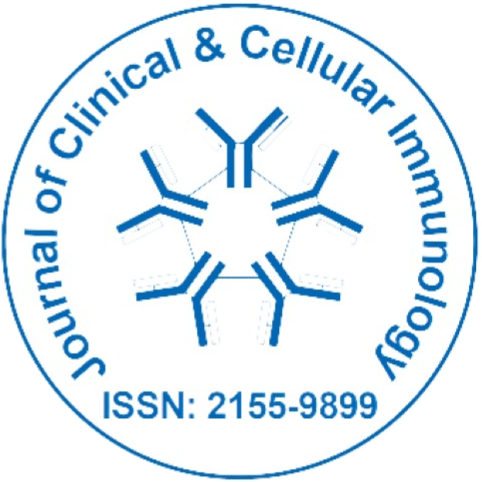
Journal of Clinical and Cellular Immunology
Open Access
ISSN: 2155-9899

ISSN: 2155-9899
Editorial - (2015) Volume 6, Issue 4
Atherosclerosis is a chronic inflammatory disease characterized by the development of atheromatous plaque, which triggers luminal narrowing and when ruptured can result in myocardial infarction or ischemic stroke. Atherosclerosis is pronounced in the intima of many middle sized and large arteries, especially where the vessels divide, and where blood flow is non-linear and exerts low shear stress, leading to increased inflammatory signaling and recruitment of monocytes [1,2]. Attracted monocytes adhere to and migrate into the vessel wall, where they differentiate into macrophages and can become lipid loaded foam cells. Upon atherosclerosis progression, additional immune cells propagate the chronic inflammation and the plaque contains a wide variety of cells and has a complex structure consisting of a necrotic, lipid rich core, and a fibrous cap, the rupture of which by macrophages secreted proteases leads to clinical phenotypes [3-5].
Among several cell types present in the plaque, macrophages are known to play a central role in different stages of atherogenesis [6]. Microphages display high heterogeneity and in response to the microenvironment adopt different polarization states such as classically activated macrophages (M1), alternatively activated macrophages (M2), Mox macrophages, and MCSF/CXCL4-dependent macrophages (M4) [6]. The M1 macrophages are regarded as pro-atherogenic [7], while M2 macrophages are regarded as both pro- and anti-atherogenic [8]. The Mox macrophages are induced by oxidized phospholipids, which are produced in atherosclerotic plaque, and are thought to exert anti-inflammatory response [9], while the function of recently identified M4 macrophages is poorly understood [10]. Although anti-inflammatory macrophages are present at the site of the plaque, it is still enigmatic why the strong inflammatory response persists at the site of artherogenesis and why it is failed to be resolved. These questions led to the hypothesis that the altered gene expression pattern of macrophages by epigenetic processes might contribute to the long-term pro-inflammatory phenotype [11].
Numerous studies have shown the contribution of altered DNA methylation pattern, aberrant histone post-translational modifications (such as histone acetylation and methylation), and deregulated miRNAs expression in the pathogenesis of atherosclerosis. Most, if not all, these epigenetic processes are implicated in the progression of atherosclerosis either by modulating endothelial cells, vascular smooth muscle cells, or macrophages. Recently, much of the research is focused on inhibiting macrophage proliferation or altering the macrophages phenotype/polarization state by epigenetic modulators in order to develop efficient strategies in management of atherosclerosis. Pharmacological targeting of histone deacetylases (HDACs), which remove acetylation modifications, is by far shown to be efficient in treatment of many neurological diseases and cancer [12]. Although broad spectrum HDAC inhibitors are shown to be promising in treatment of various diseases, the side-effects associated with these pan-HDAC inhibitors is of utmost concern. Therefore, targeting of specific HDAC proteins or a specific cell type such as macrophages is of key importance. Studies aimed at this end have identified two HDACs namely HDAC3 and HDAC9 expression to be highly associated with atherosclerosis [13,14]. Further studies have shown that the deletion of HDAC9 from macrophages results in reduced inflammatory gene expression, efficient lipid efflux and decreased foam cell formation [13]. Similarly, studies on HDAC3 depleted macrophages revealed the failure of inflammatory gene expression signature with majority of macrophages showing an anti-inflammatory macrophage M2 phenotype [14,15]. Collectively, these studies indicate that inhibition of HDAC3 and HDAC9 in macrophages as a promising tool to treat not only atherosclerosis but also other inflammatory diseases. However, safer and cell-type specific targeting methodologies are necessary to avoid undesirable side-effects. In this context, it is interesting to note that Duivenvoorden et al., 2014 have advanced the specific targeting of macrophages by statin containing high-density lipoprotein (HDL) nanoparticles, which accumulate in atherosclerotic plaques and inhibit the inflammation [16]. Henceforth, future studies aimed at HDL nanoparticles loaded with HDAC inhibitors or therapeutic miRNAs might open up new avenues for the treatment of atherosclerosis.